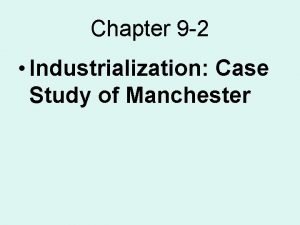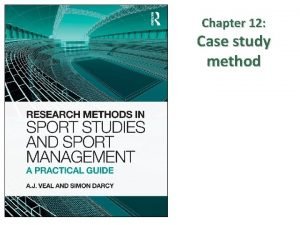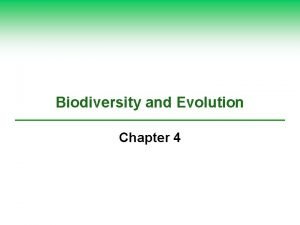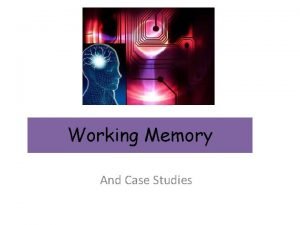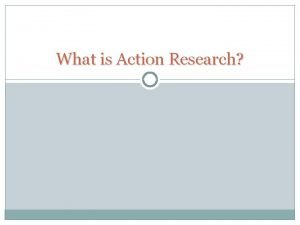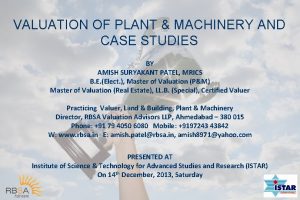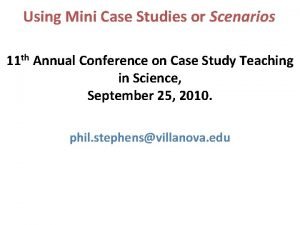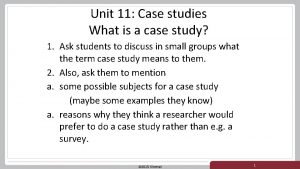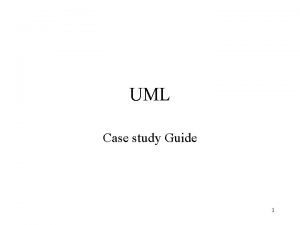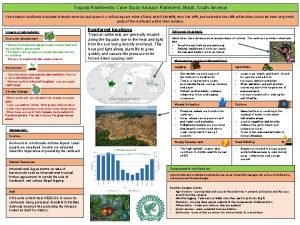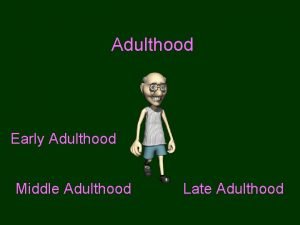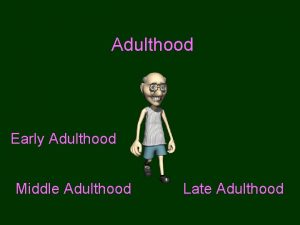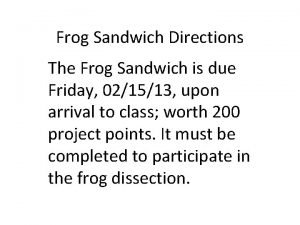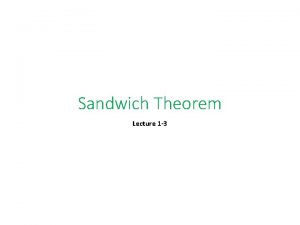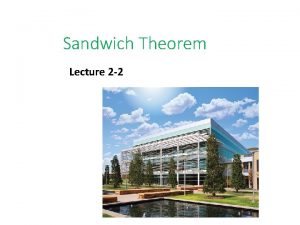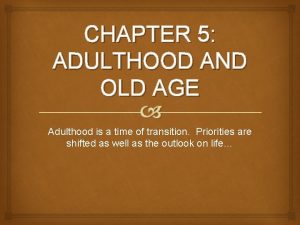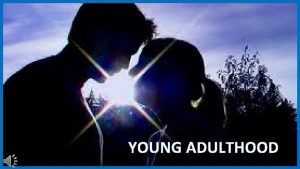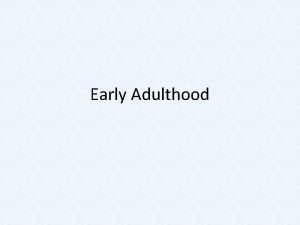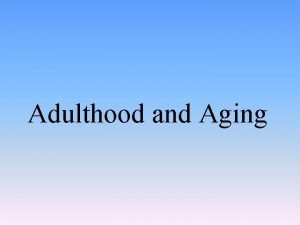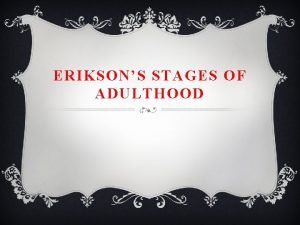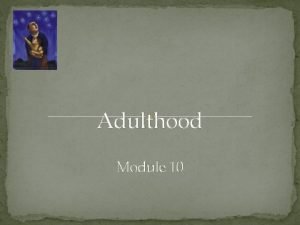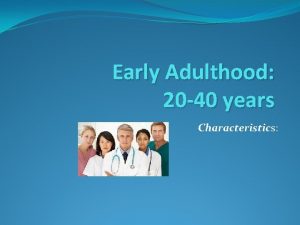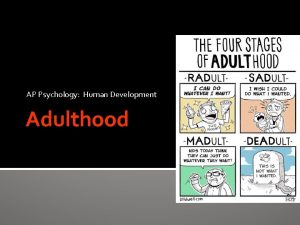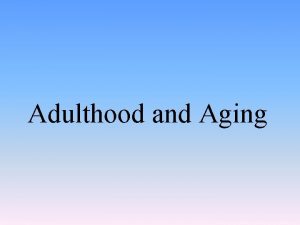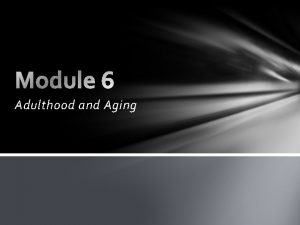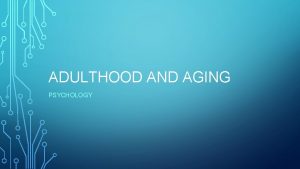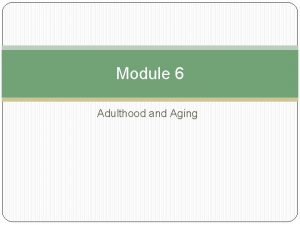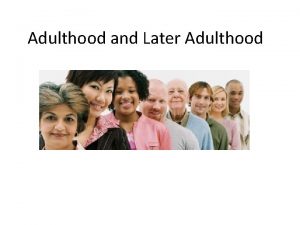Adulthood Chapter 12 Adulthood Case Study The Sandwich






































































- Slides: 70

Adulthood Chapter 12: Adulthood Case Study: The Sandwich Generation Section 1: Young Adulthood Section 2: Middle Adulthood Section 3: Late Adulthood Section 4: Death and Dying Simulation: Applying What You’ve Learned Original Content Copyright by HOLT Mc. Dougal. Additions and changes to the original content are the responsibility of the instructor.

Adulthood Case Study: The Sandwich Generation Adults who care for their children as well as their parents belong to the “sandwich generation” and face unique care-giving challenges. What Creates the Sandwich? Effects on Caregivers • Adults are living longer. • Changes in work hours • Young adults are marrying later and starting families later. • Stress • Financial difficulties • Few professional caregivers are • Less attention for spouses and available. children • About 20 million Americans • Renewed attachment to parents belong to the sandwich generation. Original Content Copyright by HOLT Mc. Dougal. Additions and changes to the original content are the responsibility of the instructor.

Adulthood What do you think? • What strain can shouldering responsibility for both one’s children and one’s aging parents place on a family? • Do you think children should be expected to take care of their elderly parents? Why or why not? Original Content Copyright by HOLT Mc. Dougal. Additions and changes to the original content are the responsibility of the instructor.

Adulthood Original Content Copyright by HOLT Mc. Dougal. Additions and changes to the original content are the responsibility of the instructor.

Adulthood Original Content Copyright by HOLT Mc. Dougal. Additions and changes to the original content are the responsibility of the instructor.

Adulthood Section 1 at a Glance Young Adulthood • Young adulthood is characterized by becoming independent from parental authority and trying new ways of doing things. • Many young adults form lasting relationships and marry. • Although most young couples marry because they are in love, many marriages in the United States end in divorce. Original Content Copyright by HOLT Mc. Dougal. Additions and changes to the original content are the responsibility of the instructor.

Adulthood Young Adulthood Main Idea During young adulthood, most men and women become independent, begin careers, and develop meaningful relationships. Reading Focus • What are some of the characteristics and goals of young adulthood? • Why are marriage and relationships important parts of young adulthood? • How does divorce affect parents and children? Original Content Copyright by HOLT Mc. Dougal. Additions and changes to the original content are the responsibility of the instructor.

Adulthood Why do some married couples come to look like each other? Original Content Copyright by HOLT Mc. Dougal. Additions and changes to the original content are the responsibility of the instructor.

Adulthood Characteristics and Goals Young adulthood is characterized by a desire to try new things and by changing relationships with parents. Reassessment Settling Down • Once young adults reach their 30 s, they often reevaluate the decisions they have made about their course in life. • The mid- to late-30 s are often characterized by settling down or “planting roots. ” • Reassessment may bring major life changes. Original Content Copyright by HOLT Mc. Dougal. Additions and changes to the original content are the responsibility of the instructor.

Adulthood Original Content Copyright by HOLT Mc. Dougal. Additions and changes to the original content are the responsibility of the instructor.

Adulthood Reading Check Analyze Why do many men and women reassess their lives in their 30 s? Answer: to determine whether their chosen courses are the best ones for them Original Content Copyright by HOLT Mc. Dougal. Additions and changes to the original content are the responsibility of the instructor.

Adulthood Marriage and Relationships The development of an identity—who you are and what you stand for —is an important part of adolescence and young adulthood. History of Marriage Choosing Spouses • In most Western societies, patriarchy has dominated marriage, but now spouses are more likely to be viewed as equal partners. • Today young Americans typically select their own spouses. • The concept of marrying for love emerged in the 1800 s. • Today companionship and intimacy are central to marriage. • Influences over the choice include ethnicity, level of education, social class, religion, and similarity in age, values, and attitudes. Original Content Copyright by HOLT Mc. Dougal. Additions and changes to the original content are the responsibility of the instructor.

Adulthood Click on the image above to play the Interactive. Original Content Copyright by HOLT Mc. Dougal. Additions and changes to the original content are the responsibility of the instructor.

Adulthood Reading Check Compare How does marriage today compare with marriage in the past? Answer: Marriage today may be based on equality between spouses, while marriage in the past may have been based on patriarchy. In addition, marriage today may be based on romantic love, while marriage in the past may have been based on the benefits for families. Original Content Copyright by HOLT Mc. Dougal. Additions and changes to the original content are the responsibility of the instructor.

Adulthood Divorce Reasons for Divorce • One reason divorce is a common occurrence is because obtaining a divorce is easier than it used to be. • People may divorce due to spousal abuse, child abuse, infidelity, stress, or an inability to communicate. The Costs of Divorce • Financial resources are usually divided in a divorce. • Divorced mothers often have primary responsibility for children. • Divorced fathers often have to pay child support and alimony. • Most divorced people recover and the majority remarry. Original Content Copyright by HOLT Mc. Dougal. Additions and changes to the original content are the responsibility of the instructor.

Adulthood The Children of Divorce • Divorce can be difficult for children, no matter what their age. • Children of divorced people are more likely to have behavioral problems, engage in substance abuse, and earn lower grades in school. • Boys often have greater problems than girls in adjusting to divorce. • Psychologists usually advise parents who are getting divorced to: – Try to agree on how they will interact with their children – Help each other maintain a good parent-child relationship – Avoid criticizing each other to or in front of their children Original Content Copyright by HOLT Mc. Dougal. Additions and changes to the original content are the responsibility of the instructor.

Adulthood Original Content Copyright by HOLT Mc. Dougal. Additions and changes to the original content are the responsibility of the instructor.

Adulthood Reading Check Summarize Why do people divorce? Answer: People may divorce due to spousal abuse, child abuse, infidelity, stress, or an inability to communicate. Original Content Copyright by HOLT Mc. Dougal. Additions and changes to the original content are the responsibility of the instructor.

Adulthood Section 2 at a Glance Middle Adulthood • One of the greatest challenges facing middle-aged adults is retaining the ability to create, originate, and produce. • During middle adulthood, many adults go through a period of reassessment and reevaluate what to do with the rest of their lives. • Many middle-aged adults have to adjust to the changing needs of their children and deal with their own physical changes. Original Content Copyright by HOLT Mc. Dougal. Additions and changes to the original content are the responsibility of the instructor.

Adulthood Middle Adulthood Main Idea During middle adulthood, men and women continue to be creative in their careers, family life, and community. They also face new life changes as they grow older. Reading Focus • What is generativity? • Why do many adults experience a midlife transition? • What life changes do people face in middle adulthood? Original Content Copyright by HOLT Mc. Dougal. Additions and changes to the original content are the responsibility of the instructor.

Adulthood Generativity • Middle adulthood spans the years from 40 to 65. • Erikson said that the greatest challenge facing middle adults is generativity—the ability to create, originate, and produce. • Generativity adds meaning to the lives of adults and helps them to maintain and enhance their self-esteem. • Erikson believed that adults who are not generative can become stagnant. Original Content Copyright by HOLT Mc. Dougal. Additions and changes to the original content are the responsibility of the instructor.

Adulthood Reading Check Identify Supporting Details How can adults maintain generativity? Answer: Adults can maintain generativity by creating, originating, and producing; specific examples might include improving methods and relationships in the workplace, guiding younger people, voting, and community service. Original Content Copyright by HOLT Mc. Dougal. Additions and changes to the original content are the responsibility of the instructor.

Adulthood Transition The midlife transition is a period of middle adulthood when people’s perspectives change in a major way. Many people experience a midlife transition around the ages of 40 to 45. Midlife Crisis or Age of Mastery? • The midlife transition can trigger a second period of reassessment known as a midlife crisis. Middlescence • Journalist Gail Sheehy calls the years from 45 to 65 the “age of mastery. ” • Middlescence can involve a search for a second adulthood. • The term middlescence is sometimes used to describe a period of searching that can resemble adolescence. Original Content Copyright by HOLT Mc. Dougal. Additions and changes to the original content are the responsibility of the instructor.

Adulthood Reading Check Summarize How do many adults respond to the midlife transition? Answer: with an acknowledgement of limitations or a sense of urgency; decision about what to do with rest of life Original Content Copyright by HOLT Mc. Dougal. Additions and changes to the original content are the responsibility of the instructor.

Adulthood Original Content Copyright by HOLT Mc. Dougal. Additions and changes to the original content are the responsibility of the instructor.

Adulthood Original Content Copyright by HOLT Mc. Dougal. Additions and changes to the original content are the responsibility of the instructor.

Adulthood Original Content Copyright by HOLT Mc. Dougal. Additions and changes to the original content are the responsibility of the instructor.

Adulthood Life Changes The Empty-Nest Syndrome • Empty-nest syndrome is the term applied to feelings of emptiness and loss parents sometimes feel after their children have left home to establish their own lives. • Once the nest is “empty, ” however, many people report positive changes in their lives. Menopause • Menopause usually occurs in a woman’s late 40 s or early 50 s and is marked by the end of menstruation. • Menopause is normal and can be a healthy development in women’s lives. Original Content Copyright by HOLT Mc. Dougal. Additions and changes to the original content are the responsibility of the instructor.

Adulthood Original Content Copyright by HOLT Mc. Dougal. Additions and changes to the original content are the responsibility of the instructor.

Adulthood Reading Check Make Generalizations Why do many people have a negative attitude toward menopause? Answer: Menopause may be considered abnormal or a disease; it is frequently associated with mood swings and irritability Original Content Copyright by HOLT Mc. Dougal. Additions and changes to the original content are the responsibility of the instructor.

Adulthood Section 3 at a Glance Late Adulthood • Regular exercise and a healthy diet can help older adults reduce the impact of the physical changes they undergo. • People age as their cells age and begin to malfunction. • Cognitive changes, including memory decline, occur in late adulthood, but most older adults do quite well intellectually. • Aging involves social changes that involve work, family, and living arrangements. • Older adults who age successfully continue to believe that life is meaningful and full. Original Content Copyright by HOLT Mc. Dougal. Additions and changes to the original content are the responsibility of the instructor.

Adulthood Late Adulthood Main Idea Late adulthood is a time of many changes—physical, cognitive, and social. The ways in which older adults handle all these changes can determine how successfully they age. Reading Focus • What physical changes are part of late adulthood? • Why do people age? • What cognitive changes occur in late adulthood? • How do social changes affect older adults? • How can older adults age successfully? Original Content Copyright by HOLT Mc. Dougal. Additions and changes to the original content are the responsibility of the instructor.

Adulthood What's the secret of long life? Original Content Copyright by HOLT Mc. Dougal. Additions and changes to the original content are the responsibility of the instructor.

Adulthood Physical Changes • Age 65 marks the beginning of late adulthood. • Many physical changes take place in late adulthood. • Some physical changes cause health problems. • Older adults can do many things to maintain their health, strength, and energy. • Regular exercise and a healthful diet can help older adults feel better and help them fight disease. Original Content Copyright by HOLT Mc. Dougal. Additions and changes to the original content are the responsibility of the instructor.

Adulthood Reading Check Identify Supporting Details What can older adults do to help maintain their health and strength? Answer: Older adults can exercise and eat healthy diets to maintain their health and strength. Original Content Copyright by HOLT Mc. Dougal. Additions and changes to the original content are the responsibility of the instructor.

Adulthood Why People Age Programmed Theories • The developmental theories that maintain that aging is the result of genetics are called programmed theories. • These theories suggest that heredity and genetics play a significant role in the length of one’s life. Cellular Damage Theories • Cellular damage theories suggest that cells malfunction as a result of damage, not heredity. • Some scientists blame free radicals, or unstable molecules in our bodies, for damage. • Cross-linking may be another cause of aging. Original Content Copyright by HOLT Mc. Dougal. Additions and changes to the original content are the responsibility of the instructor.

Adulthood Reading Check Contrast What is a major difference between programmed theories and cellular damage theories? Answer: programmed theories—people cannot control heredity or genetics; cellular damage theories—people have some degree of control over environmental toxins that may cause cellular damage Original Content Copyright by HOLT Mc. Dougal. Additions and changes to the original content are the responsibility of the instructor.

Adulthood Cognitive Changes Senile Dementia • Dementia is the serious loss of cognitive functioning. • People with dementia have major losses in memory and may have speech or motor problems. • Dementia that occurs after age 65 is called senile dementia. Most cases occur in people over 80. Alzheimer’s Disease • Alzheimer’s disease is a progressive form of mental deterioration that affects about 10 percent of people over the age of 65 and nearly half of those over the age of 85. • It is a disease and not a normal part of aging. Original Content Copyright by HOLT Mc. Dougal. Additions and changes to the original content are the responsibility of the instructor.

Adulthood Original Content Copyright by HOLT Mc. Dougal. Additions and changes to the original content are the responsibility of the instructor.

Adulthood Vascular Dementia • Vascular dementia is another common kind of dementia. • It can be caused by a stroke or by a decrease in the blood supply to the brain. • Such a decrease happens when fatty deposits collect in the blood vessels that go to the brain. Original Content Copyright by HOLT Mc. Dougal. Additions and changes to the original content are the responsibility of the instructor.

Adulthood Reading Check Summarize What are the characteristics of Alzheimer’s disease? Answer: gradual deterioration of mental processes, reduced levels of the neurotransmitter acetylcholine, and the build up of sticky plaque in the brain Original Content Copyright by HOLT Mc. Dougal. Additions and changes to the original content are the responsibility of the instructor.

Adulthood Social Changes Retirement • Retirement can be voluntary or compulsory. • People who retire from full-time work sometimes continue working part time, either paid or voluntary. Grandparenthood • Grandparents often have more relaxed relationships with their grandchildren than they had with their children. • Increasing numbers of grandparents, however, take on the major responsibility of raising their grandchildren. Original Content Copyright by HOLT Mc. Dougal. Additions and changes to the original content are the responsibility of the instructor.

Adulthood Living Arrangements • Some Americans have stereotypes about older people’s living arrangements. • One stereotype portrays older people living with their children and another has them in nursing homes and other institutions. Yet another says that they buy condominiums or move to retirement communities in warmer climates. • On the contrary, most older people are independent. • Many are financially independent and own their own homes. • Most remain in their hometowns. • Nearly 30 percent of older people will spend some time in a nursing home, but people living in nursing homes usually are 80 or older. Original Content Copyright by HOLT Mc. Dougal. Additions and changes to the original content are the responsibility of the instructor.

Adulthood Reading Check Make Generalizations What role can older adults play in their loved ones’ lives? Answer: Older adults can provide wisdom, love, and support for their loved ones. Original Content Copyright by HOLT Mc. Dougal. Additions and changes to the original content are the responsibility of the instructor.

Adulthood Original Content Copyright by HOLT Mc. Dougal. Additions and changes to the original content are the responsibility of the instructor.

Adulthood Successful Aging Ego Integrity • Erikson believed that one challenge facing people in late adulthood is how they maintain ego integrity—the belief that life is meaningful and worthwhile even when physical abilities are not what they used to be. Aging and Adjustment • Most people in their 70 s report satisfaction with their lives. • There is a correlation between socioeconomic status and health. • Older people benefit from social support and feelings of personal well -being. Original Content Copyright by HOLT Mc. Dougal. Additions and changes to the original content are the responsibility of the instructor.

Adulthood Reshaping One’s Life • Reshaping one’s life to focus on what is important is another component of successful aging. A Positive Outlook • A positive outlook is another component of successful aging. Original Content Copyright by HOLT Mc. Dougal. Additions and changes to the original content are the responsibility of the instructor.

Adulthood Self-Challenge • Another component of successful aging is challenging oneself. • The formula is simple, can be used by everyone, and includes: – Increasing participation in activities – Making more close friends – Visiting with family – Spending quiet time reading and listening to music Original Content Copyright by HOLT Mc. Dougal. Additions and changes to the original content are the responsibility of the instructor.

Adulthood Original Content Copyright by HOLT Mc. Dougal. Additions and changes to the original content are the responsibility of the instructor.

Adulthood Reading Check Identify Cause and Effect What can happen when older adults do not have a positive outlook? Answer: When older adults do not have positive outlooks, they may die sooner than their counterparts with positive outlooks. Original Content Copyright by HOLT Mc. Dougal. Additions and changes to the original content are the responsibility of the instructor.

Adulthood Current Research in Psychology Living in the Moment What do you want to do with the rest of your life? With your future stretching far into the distance, you probably have plenty of ideas. But suppose you didn’t have so much time? How would your priorities change? How would you make the most of the time you have left? These are questions that those in late adulthood have to consider. • The theory of socioemotional selectivity holds that our perception of time plays an important role in the types of goals we set. • Young adults tend to set long-term goals. Older adults tend to set short -term goals. They also begin to restrict their social network. • Older adults become better at controlling their emotions, especially negative ones. • Many older adults want to live in the moment. Original Content Copyright by HOLT Mc. Dougal. Additions and changes to the original content are the responsibility of the instructor.

Adulthood Original Content Copyright by HOLT Mc. Dougal. Additions and changes to the original content are the responsibility of the instructor.

Adulthood Thinking Critically • How might the fact that older adults’ emotions seem to “mellow with age” enhance their well-being? • Think about a situation when your time with friends was limited. What were your main goals during this period? Original Content Copyright by HOLT Mc. Dougal. Additions and changes to the original content are the responsibility of the instructor.

Adulthood Section 4 at a Glance Death and Dying • A much criticized theory states that the stages of dying include denial, anger, bargaining, depression, and acceptance. • Dying people need support, relief from pain, and a dignified end. • Funerals help the living celebrate the life of the deceased and cope with sadness. Original Content Copyright by HOLT Mc. Dougal. Additions and changes to the original content are the responsibility of the instructor.

Adulthood Death and Dying Main Idea People deserve to die with dignity and the support of those who love them. After someone dies, the living often depend on religious beliefs and traditional customs to cope with their sadness. Reading Focus • What are the stages of dying? • How can people help a loved one die with dignity? • How do people deal with death? Original Content Copyright by HOLT Mc. Dougal. Additions and changes to the original content are the responsibility of the instructor.

Adulthood What message would you leave behind? Original Content Copyright by HOLT Mc. Dougal. Additions and changes to the original content are the responsibility of the instructor.

Adulthood Stages of Dying • Psychiatrist Elisabeth Kübler-Ross theorized there are five stages through which many dying people pass. The stages are – Denial – Anger – Bargaining – Depression – Acceptance • Kübler-Ross’s theory has met with considerable criticism. • Psychologist Edwin Shneidman has not found that feelings about dying follow a particular sequence. • Another problem is that theory may tempt people to ignore the uniqueness of each individual’s experiences at the end of life. Original Content Copyright by HOLT Mc. Dougal. Additions and changes to the original content are the responsibility of the instructor.

Adulthood Reading Check Analyze Why has Kübler-Ross’s theory been criticized? Answer: It is falsely sequential and ignores the uniqueness of each individual’s experiences at the end of life. Original Content Copyright by HOLT Mc. Dougal. Additions and changes to the original content are the responsibility of the instructor.

Adulthood Dying with Dignity The Hospice Alternative • Dying people need to feel cared for and supported. They may also need relief from pain. • Dying people need security, selfconfidence, and dignity. • Some dying people enter a hospice, a homelike place where dying people and their families receive physical and emotional support to help them cope with terminal illness. Euthanasia The Living Will • Euthanasia is illegal in most states. • Many people write living wills, which are legal documents in which a person requests to be allowed to die rather than be kept alive by artificial means if disabled beyond a reasonable expectation of recovery. • Many people support making it legal with clear restrictions. Others argue that no one has the right to take a life, even one’s own. Original Content Copyright by HOLT Mc. Dougal. Additions and changes to the original content are the responsibility of the instructor.

Adulthood Reading Check Summarize How can people help a dying person achieve a sense of peace? Answer: by understanding the extent of the dying person’s need for details and information, by respecting the dying person as an individual with the right to know what to expect Original Content Copyright by HOLT Mc. Dougal. Additions and changes to the original content are the responsibility of the instructor.

Adulthood Original Content Copyright by HOLT Mc. Dougal. Additions and changes to the original content are the responsibility of the instructor.

Adulthood Dealing with Death The Funeral • The funeral is a traditional way to acknowledge that a member of the community has died. • Funerals reflect religious beliefs and cultural practices. • Funerals are a way of saying good-bye to the deceased. • They provide a way to remember and celebrate the life of the deceased. Bereavement • People who are bereaved are mourning over the person they have lost. • Bereaved people may feel sadness, loneliness, anger, numbness, and even relief. Most bereaved people eventually recover from their loss. Original Content Copyright by HOLT Mc. Dougal. Additions and changes to the original content are the responsibility of the instructor.

Adulthood Reading Check Identify Supporting Details What is the purpose of a funeral? Answer: to acknowledge that a family member or friend has died Original Content Copyright by HOLT Mc. Dougal. Additions and changes to the original content are the responsibility of the instructor.

Adulthood Cultural Diversity and Psychology Cultural Perspectives on Grief and Death People everywhere grieve when a loved one dies. However, the form that their grief takes and the rituals people observe in the face of death vary from culture to culture. To a great extent, our culture shapes us and the way we look at the world. The way we express grief and respond to death is no less a product of culture. • Mexicans celebrate the Day of the Dead every November. • According to some traditional African religions, the dead are believed to continue their existence in a spirit world where they have the power to help or harm the living. • Chinese funeral customs involve lengthy services that can last up to 49 days. • Traditional Jewish funerals include a simple burial ceremony, followed by a seven-day period of mourning called Shivah. Original Content Copyright by HOLT Mc. Dougal. Additions and changes to the original content are the responsibility of the instructor.

Adulthood Original Content Copyright by HOLT Mc. Dougal. Additions and changes to the original content are the responsibility of the instructor.

Adulthood Original Content Copyright by HOLT Mc. Dougal. Additions and changes to the original content are the responsibility of the instructor.

Adulthood Thinking Critically • What similar attitude toward the dead do all of these cultural traditions reveal? • What different funeral traditions have you heard about? Original Content Copyright by HOLT Mc. Dougal. Additions and changes to the original content are the responsibility of the instructor.

Adulthood Simulation: Applying What You’ve Learned Experiencing the Stages of Adulthood What would you like to say to your future self? How might you see yourself looking back as an older adult? 1. Introduction 2. Generate Ideas • In this simulation, you will write two letters to yourself—one addressed to yourself in late adulthood and the other written from the point of view of your older self. • Work with your group to discuss what you have learned about the stages of adulthood. • The simulation will help you think about what the stages of adulthood might hold for you. • Generate ideas about what life might be like for you in young adulthood, middle adulthood, and late adulthood. Original Content Copyright by HOLT Mc. Dougal. Additions and changes to the original content are the responsibility of the instructor.

Adulthood Simulation (con’t. ) 3. Write the Letters 4. Share and Discuss the Letters • Write the two letters on your own. • Take turns reading the letters aloud and discussing them. • Remember that in the first letter you are writing to yourself 50 years in the future. • The second letter should be a response to the first letter, written from the point of view of yourself as an older adult. • Read the three quotations about aging on the next slide. • Are your attitudes about aging different after completing this simulation? • Do the younger and older versions of yourself agree or disagree with the quotations? Original Content Copyright by HOLT Mc. Dougal. Additions and changes to the original content are the responsibility of the instructor.

Adulthood Original Content Copyright by HOLT Mc. Dougal. Additions and changes to the original content are the responsibility of the instructor.
 Fillings and spread
Fillings and spread Best worst and average case
Best worst and average case It project failure case study
It project failure case study Chapter 9 section 2 industrialization case study manchester
Chapter 9 section 2 industrialization case study manchester Chapter 12 case study
Chapter 12 case study Chapter 10 case study
Chapter 10 case study Case study chapter 4
Case study chapter 4 Hình ảnh bộ gõ cơ thể búng tay
Hình ảnh bộ gõ cơ thể búng tay Bổ thể
Bổ thể Tỉ lệ cơ thể trẻ em
Tỉ lệ cơ thể trẻ em Chó sói
Chó sói Tư thế worms-breton
Tư thế worms-breton Hát lên người ơi alleluia
Hát lên người ơi alleluia Môn thể thao bắt đầu bằng từ chạy
Môn thể thao bắt đầu bằng từ chạy Thế nào là hệ số cao nhất
Thế nào là hệ số cao nhất Các châu lục và đại dương trên thế giới
Các châu lục và đại dương trên thế giới Công của trọng lực
Công của trọng lực Trời xanh đây là của chúng ta thể thơ
Trời xanh đây là của chúng ta thể thơ Mật thư anh em như thể tay chân
Mật thư anh em như thể tay chân Phép trừ bù
Phép trừ bù Phản ứng thế ankan
Phản ứng thế ankan Các châu lục và đại dương trên thế giới
Các châu lục và đại dương trên thế giới Thể thơ truyền thống
Thể thơ truyền thống Quá trình desamine hóa có thể tạo ra
Quá trình desamine hóa có thể tạo ra Một số thể thơ truyền thống
Một số thể thơ truyền thống Cái miệng nó xinh thế
Cái miệng nó xinh thế Vẽ hình chiếu vuông góc của vật thể sau
Vẽ hình chiếu vuông góc của vật thể sau Thế nào là sự mỏi cơ
Thế nào là sự mỏi cơ đặc điểm cơ thể của người tối cổ
đặc điểm cơ thể của người tối cổ V. c c
V. c c Vẽ hình chiếu đứng bằng cạnh của vật thể
Vẽ hình chiếu đứng bằng cạnh của vật thể Fecboak
Fecboak Thẻ vin
Thẻ vin đại từ thay thế
đại từ thay thế điện thế nghỉ
điện thế nghỉ Tư thế ngồi viết
Tư thế ngồi viết Diễn thế sinh thái là
Diễn thế sinh thái là Dạng đột biến một nhiễm là
Dạng đột biến một nhiễm là Bảng số nguyên tố lớn hơn 1000
Bảng số nguyên tố lớn hơn 1000 Tư thế ngồi viết
Tư thế ngồi viết Lời thề hippocrates
Lời thề hippocrates Thiếu nhi thế giới liên hoan
Thiếu nhi thế giới liên hoan ưu thế lai là gì
ưu thế lai là gì Sự nuôi và dạy con của hươu
Sự nuôi và dạy con của hươu Sự nuôi và dạy con của hươu
Sự nuôi và dạy con của hươu Sơ đồ cơ thể người
Sơ đồ cơ thể người Từ ngữ thể hiện lòng nhân hậu
Từ ngữ thể hiện lòng nhân hậu Thế nào là mạng điện lắp đặt kiểu nổi
Thế nào là mạng điện lắp đặt kiểu nổi Long case vs short case
Long case vs short case Binary search complexity average case
Binary search complexity average case Glennan building cwru
Glennan building cwru Bubble sort best case and worst case
Bubble sort best case and worst case Bubble sort best case and worst case
Bubble sort best case and worst case Bubble sort best case and worst case
Bubble sort best case and worst case Law of sines two solutions
Law of sines two solutions Zara mis
Zara mis Sheryl kantrowitz
Sheryl kantrowitz K.f case study
K.f case study Beth anders
Beth anders Action research vs case study
Action research vs case study Volkswagen of america managing it priorities
Volkswagen of america managing it priorities Valuation of plant machinery and equipment
Valuation of plant machinery and equipment Phil stephens villanova
Phil stephens villanova Starbucks foreign direct investment
Starbucks foreign direct investment Case study 11
Case study 11 Notasi uml
Notasi uml Illustrative case study example
Illustrative case study example Tuna for lunch case study answers
Tuna for lunch case study answers Tuna for lunch case study answer key
Tuna for lunch case study answer key Amazon rainforest case study
Amazon rainforest case study



